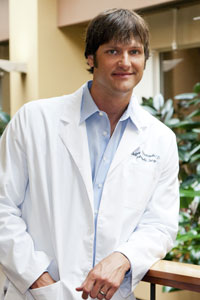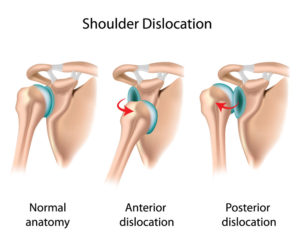Dislocated Shoulder & Shoulder Instability Specialist

Are you an athlete who participates in contact sports? If so, you may be at risk of a dislocated shoulder. A dislocated shoulder can occur from a sports injury, traumatic blow to the shoulder or from continuous overhead movements. Dislocated shoulder specialist, Dr. Jeff Padalecki provides diagnosis and both surgical and nonsurgical treatment options for patients in Austin who have suffered a dislocated shoulder or shoulder separation. Contact Dr. Padalecki’s team today!
How does a Dislocated Shoulder Cause Shoulder Instability?
The shoulder joint is one of the most mobile joints in the human body. This tremendous mobility can become disabling when a dislocation disrupts the normal stabilizers of the shoulder and leads to an unstable joint. During a dislocation, the ball and socket within the shoulder joint become separated. The shoulder can dislocate forward, backward or downward. Some individuals will have what is referred to as multidirectional instability (or MDI) which is often found in people that are “loose-jointed.” Dr. Jeff Padalecki, shoulder specialist serving Austin, Round Rock, and Cedar Park, Texas communities, is well trained in treating patients with this shoulder injury.
Athletes, in particular, are at risk for a shoulder dislocation when participating in competitive activities. In addition, athletes who compete in sports that involve overhead movements are especially at risk. Examples include basketball players, swimmers, pitchers, and tennis players. The repetitive, constant overhead motion can lead to wear and tear of the ligaments, muscles and other structures that normally secure the shoulder joint. This wear and tear leaves the joint susceptible to a dislocation.
Traumatic accidents are a common cause of shoulder dislocation. Acute dislocations are often caused by direct impact (such as in football) or other traumatic events (such as a car accident). Patients who have dislocated their shoulder in the past will often have weaker ligaments leading to chronic instability and ongoing dislocations. In young adults (35 and under) who sustain a traumatic dislocation, shoulder instability follows in the vast majority of cases. Individuals who are “double-jointed” or have connective tissue disorders may also be at greater risk for having loose ligaments which make them more susceptible to a dislocated shoulder.
What are the Symptoms of a Dislocated Shoulder?
The symptoms associated with a shoulder dislocation include:
- Muscle spasms
- Significant pain, which can be also felt along the arm
- Difficulty or inability to move the arm from its current position
- Numbness in the arm
- A “popping” sensation
- A visibly displaced shoulder
- Some discoloration or bruising
- Shoulder weakness
Prompt medical treatment should be sought for any suspected dislocation injury. Emergent care is focused on returning the shoulder to its normal position via a process known as reduction, whereby several methods are used to manually manipulate the dislocation and put the ball back into the socket. This procedure typically minimizes pain immediately when completed.
What is the Treatment for a Dislocated Shoulder?
After the shoulder is stabilized, Dr. Padalecki will conduct a thorough examination to observe the shoulder and range of motion. A variety of tests may be utilized to determine the state of the injury and the likelihood of recurrence through x-rays and MRI diagnostic tests.
Non-Surgical
Dr. Padalecki may immobilize the shoulder in a sling or other device for several weeks following treatment. Rest and icing the area multiple times a day can help with the initial healing process.
In many cases, patients who experience shoulder instability or who have a shoulder dislocation can begin a structured physical therapy rehabilitation program, which utilizes exercises to restore the shoulder’s range of motion and strengthen the muscles.
Surgical
If a shoulder dislocation and ongoing instability becomes a chronic condition, and physical therapy is not successful in strengthening the area, surgery may be needed to repair or tighten the injured ligaments. This option is particularly common among young athletes and can allow a return to athletics. Dr. Padalecki prefers to treat this condition with arthroscopic repair and has the ultimate goal of quickly returning patients to their activities.
Post-Op Instructions
A rehabilitation program will be prescribed at your first post-operative visit with Dr. Padalecki. Rehabilitation after surgery is as important as the surgical repair itself. Exercises to rehabilitate the ligaments will improve the range of motion in the shoulder and prevent scar formation during the healing process. Exercises to strengthen your shoulder will gradually be added as you aim to resume normal activities.
For more information on shoulder dislocations and shoulder instability, or to learn more about arthroscopic shoulder surgery as a treatment option, please contact the Austin, Texas orthopedic practice of shoulder specialist Dr. Jeff Padalecki.
